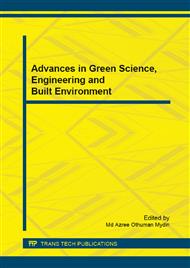p.101
p.105
p.109
p.123
p.127
p.132
p.136
p.141
p.145
Green Infrastructure Development in Sustainable Water Resources Management System
Abstract:
The main challenge in the twenty-first century is to work towards a more resilient urban world and sustainable. In the context of a global urban strategy, endurance is the attention to the capacity of urban systems, including the natural environment, the built environment, social and economic elements; to be able to manage change, to learn from a difficult situation and be in a position to rise from urban problems. Globally, the townsfolk face a water crisis within the next ten years, as the impact of climate change in exhaust emissions will affect the quality of air, land and water; which will ultimately reduce the quality of the environment. Sustainability questioned whether certain aspects of the day-to-day activities, and the systems of community life, can be ongoing into the futureonce again from the standpoint of social, economic and environmental. Eco city is a phrase that is often used in ecological issues raised in the concept of sustainable urban planning and green city embodiment of the challenges ahead in sustainable economic development, and the future development of smart green city. The convergence of technology and environmental issues has changed the world economy that offers a green city promising future - a city that appreciates natural heritage and offer all parties involved. This paper will discuss green infrastructure as water management control system in urban development concepts that contribute to build a sustainable green city management.Key words : green infrastructure, water management system.
Info:
Periodical:
Pages:
127-131
Citation:
Online since:
March 2015
Authors:
Price:
Сopyright:
© 2015 Trans Tech Publications Ltd. All Rights Reserved
Share:
Citation:


